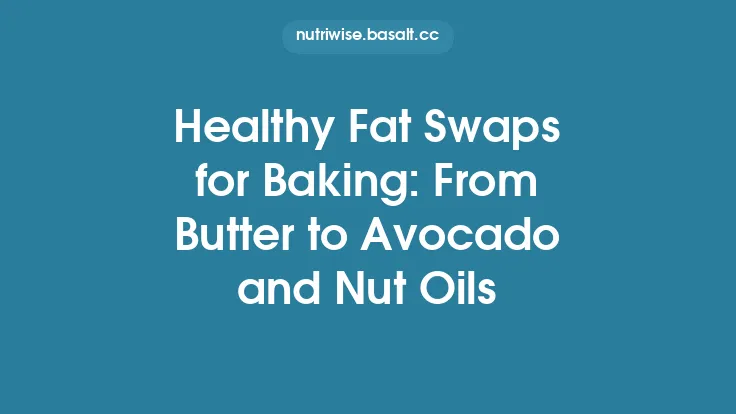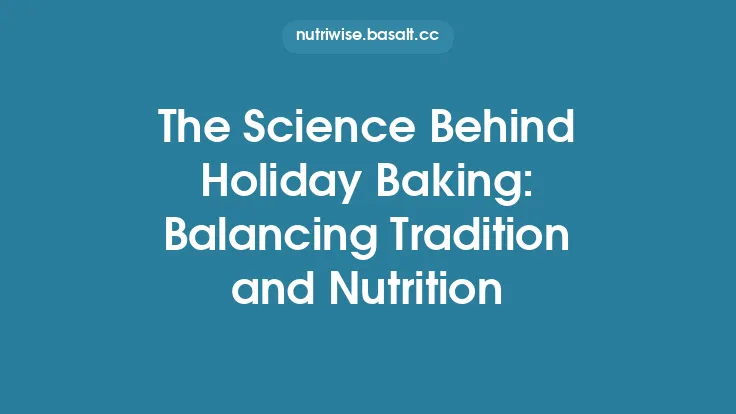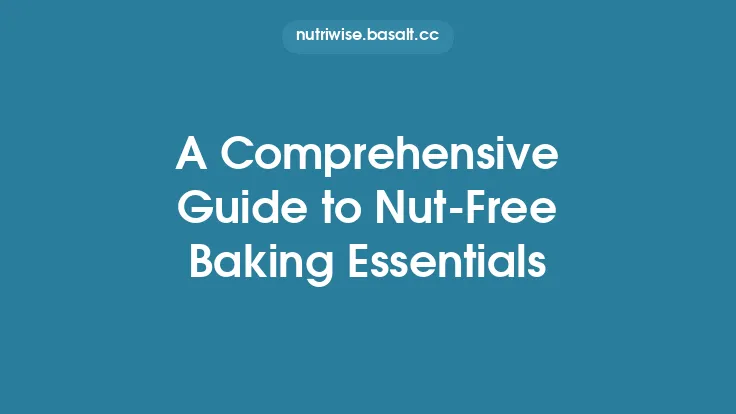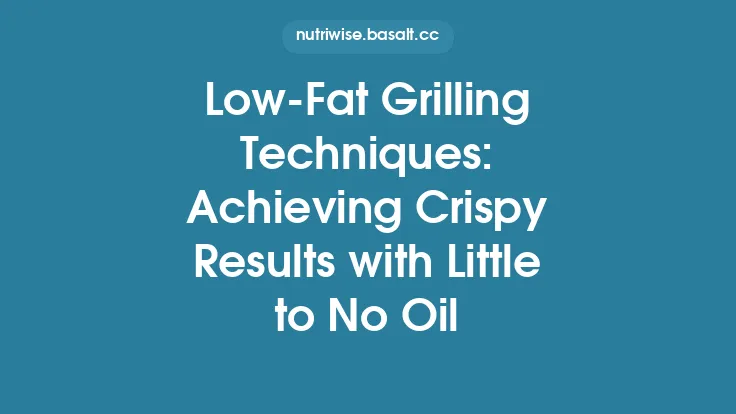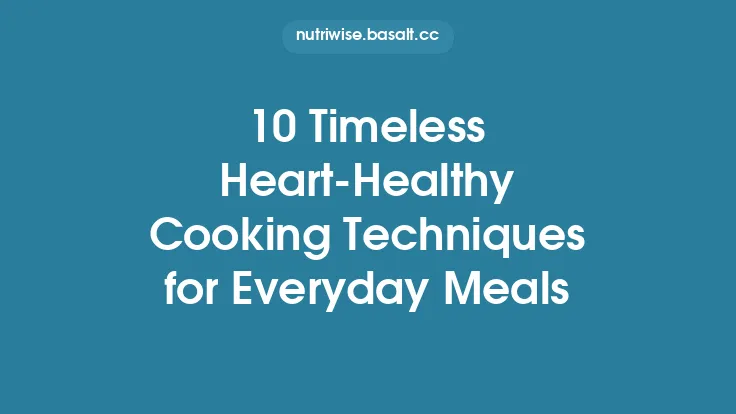Baking is often synonymous with indulgent, buttery pastries and dense, rich cakes. Yet the same principles that give baked goods their tender crumb and lofty rise can be harnessed to create low‑calorie versions that feel just as satisfying. By understanding how structure, moisture, and air interact in a batter or dough, you can dramatically cut fat without sacrificing the airy, melt‑in‑your‑mouth texture that makes baked treats so appealing. Below is a deep dive into the science‑backed techniques and ingredient swaps that let you bake light, fluffy, and low‑calorie goodies every time.
Understanding the Role of Fat in Traditional Baking
Fat performs several key functions in baked goods:
- Tenderizing – Fat coats flour proteins, limiting gluten development and resulting in a softer crumb.
- Moisture Retention – Fat is a liquid at room temperature, helping to keep baked items moist during and after baking.
- Flavor Carrier – Many flavor compounds are fat‑soluble, so fat amplifies taste perception.
When you reduce fat, you must replace these functional contributions with other ingredients or techniques. The goal isn’t to eliminate fat entirely—just to use the minimum amount needed for texture while keeping calories low.
Leveraging Leavening Agents for Lift and Lightness
Leavening is the primary driver of an airy structure. Proper use of chemical leaveners (baking soda, baking powder) and biological leaveners (yeast, sourdough starter) can compensate for reduced fat:
- Baking Powder: A balanced mix of an acid (cream of tartar) and a base (baking soda) that releases CO₂ when hydrated and again when heated. Use the “double‑acting” type for a two‑stage rise, which helps create a higher crumb even with less fat.
- Baking Soda + Acidic Ingredients: Pair ¼ tsp baking soda with ½ tsp lemon juice, vinegar, or buttermilk per cup of flour to generate a rapid burst of gas. The acid also strengthens the gluten network, offsetting the tenderizing loss from reduced fat.
- Yeast: For breads and rolls, a longer fermentation period builds flavor and gas bubbles, allowing you to keep butter or oil to a minimum.
Tip: Over‑mixing batter with chemical leaveners can collapse the gas cells. Mix just until combined, then fold in air‑incorporating ingredients (see next section).
The Power of Air: Whipping, Folding, and Incorporating Air
Air is the cheapest, calorie‑free leavening tool. Mastering techniques that trap and stabilize air can dramatically improve volume:
- Egg White Foams: Whisk egg whites to stiff peaks, then gently fold them into the batter. The protein matrix stabilizes air bubbles, creating a sponge‑like crumb. For low‑calorie recipes, use only the whites (or replace a portion with aquafaba, see later).
- Creaming Method with Minimal Fat: Traditional creaming (butter + sugar) incorporates air, but you can achieve similar aeration with a small amount of low‑fat butter or a light oil spray combined with vigorous mixing.
- Sifting and Folding: Sift dry ingredients (flour, leaveners, salt) to introduce air, then fold them into the wet mixture with a spatula using a “cut‑and‑turn” motion. This preserves the air bubbles already present.
Technical Note: The stability of air bubbles depends on surface tension. Proteins (egg whites, dairy proteins) and polysaccharides (starches, gums) lower surface tension, allowing bubbles to persist longer during baking.
Low‑Fat Dairy and Non‑Dairy Alternatives that Contribute Moisture
Moisture is essential for a tender crumb, especially when fat is reduced. Choose low‑calorie liquids that also provide structure:
- Skim Milk or Low‑Fat Yogurt: Both supply whey proteins that strengthen the crumb while adding moisture. Yogurt’s slight acidity also reacts with baking soda for extra lift.
- Buttermilk (Low‑Fat): The acidity reacts with baking soda, creating CO₂, while the thin consistency adds moisture without extra calories.
- Silken Tofu (Blended): Provides a creamy texture with minimal fat and adds plant‑based protein, which helps trap air. Use ¼ cup blended tofu for every ¼ cup butter reduced.
- Unsweetened Almond or Soy Milk: Very low in calories; the added protein can aid in structure, especially when combined with a small amount of flour or starch.
When substituting, keep the liquid‑to‑dry ratio balanced (generally 1 cup liquid per 1 cup flour for cakes, slightly less for quick breads). Too much liquid can cause a gummy crumb; too little leads to dryness.
Starch and Protein Interplay: Creating Structure without Fat
Starches gelatinize during baking, forming a network that traps gas bubbles. Enhancing this network can offset the tenderizing loss from reduced fat:
- Cornstarch or Potato Starch: Replace up to ¼ cup of all‑purpose flour with starch to create a lighter crumb. Starch gelatinizes at lower temperatures, giving a softer texture.
- Rice Flour: Naturally low in fat and gluten, it contributes a delicate, airy texture when used in combination with a small amount of wheat flour for structure.
- Egg Whites: Besides aeration, the proteins coagulate and set the crumb, providing firmness without added fat.
Pro Tip: A blend of 70 % wheat flour and 30 % starch often yields a cake‑like crumb with fewer calories than a 100 % wheat flour recipe.
Using Aquafaba and Other Plant‑Based Foams
Aquafaba—the viscous liquid from canned chickpeas—behaves remarkably like egg whites:
- Whipping: One tablespoon of aquafaba can replace one egg white. Whip to stiff peaks, then fold into batter.
- Stabilization: Add a pinch of cream of tartar or ¼ tsp lemon juice to improve foam stability.
Because aquafaba is virtually fat‑free and low in calories, it’s an excellent tool for vegan or low‑fat baking. It also adds a subtle, neutral flavor, making it versatile across sweet and savory applications.
Temperature and Baking Time Strategies for Airy Results
Heat management influences how quickly gas expands and how the crumb sets:
- Preheat Thoroughly: A hot oven (375–400 °F for cakes, 425 °F for quick breads) creates a rapid rise, “locking in” air bubbles before they can escape.
- Steam Burst: Introduce steam in the first 5–10 minutes (place a pan of water in the oven or spray the oven walls). Steam delays crust formation, allowing the interior to expand fully, which is especially helpful when fat is low.
- Avoid Over‑Baking: Prolonged exposure dries out low‑fat products. Use a toothpick test—when it comes out with a few moist crumbs, the bake is done.
Incorporating Minimal Fat with Sprays and Mists
When a touch of fat is indispensable (e.g., to prevent sticking or to add a slight richness), use it sparingly:
- Oil Sprays: A quick mist of a high‑quality oil (olive, avocado) adds less than 5 cal per spray, enough to lubricate pans without significantly raising calorie count.
- Butter Mists: Melt a small amount of butter, then use a spray bottle to mist the batter surface before baking. This creates a subtle crust while keeping overall fat low.
Practical Recipe Transformations: Case Studies
1. Classic Vanilla Cupcakes (Original: ½ cup butter, 1 cup sugar, 2 eggs, 1 ½ cups flour)
- Fat Reduction: Replace ½ cup butter with ¼ cup unsweetened applesauce (adds moisture) + 2 tsp oil spray mixed into batter.
- Air Incorporation: Whip 2 egg whites to stiff peaks, fold in after combining wet and dry ingredients.
- Starch Boost: Substitute ¼ cup of the flour with cornstarch.
- Result: Cupcakes retain a fluffy crumb, are ~30 % lower in calories, and have a moist interior.
2. Light Lemon Loaf (Original: ⅓ cup oil, 1 cup sugar, 2 eggs, 1 ¾ cups flour)
- Fat Reduction: Use ¼ cup low‑fat Greek yogurt + 2 tsp oil spray.
- Leavening: Add ½ tsp baking soda + ½ cup low‑fat buttermilk (acidic) for extra lift.
- Aquafaba: Replace 2 eggs with 6 Tbsp aquafaba whipped to peaks.
- Result: The loaf rises high, has a tender crumb, and cuts calories by roughly 25 %.
Troubleshooting Common Issues in Low‑Fat, Airy Bakes
| Symptom | Likely Cause | Fix |
|---|---|---|
| Dense, heavy crumb | Insufficient air incorporation or over‑mixing | Whip egg whites/aquafaba to stiff peaks; fold gently; avoid over‑mixing after adding leaveners |
| Cracks on top | Oven too hot or batter too dry | Reduce oven temperature by 10–15 °F; add an extra tablespoon of low‑fat liquid |
| Dry, crumbly texture | Too much flour or not enough moisture | Increase low‑fat liquid (skim milk, yogurt) by 1–2 Tbsp; check flour measurement (spoon & level) |
| Flat, unrisen product | Leavening deactivated (old powder) or insufficient acid | Verify leavening freshness; add a small amount of acid (cream of tartar, lemon juice) if using baking soda |
| Gummy interior | Excess starch without enough heat | Increase baking time slightly; ensure batter is not overly thick |
Final Thoughts: Balancing Health and Sensory Appeal
Low‑calorie baking doesn’t have to mean sacrificing the light, airy textures that make pastries irresistible. By:
- Maximizing air through whipped proteins and careful folding,
- Strategically using leaveners to generate gas,
- Employing low‑fat moisture carriers (skim dairy, yogurt, aquafaba), and
- Fine‑tuning bake temperature and time to preserve lift,
you can craft treats that delight the palate while keeping the calorie count modest. The key is to view each ingredient and technique as a functional component—whether it provides structure, moisture, or lift—and then replace or adjust it with a lower‑calorie counterpart that fulfills the same role. With practice, these methods become second nature, empowering you to bake healthier, fluffier, and more satisfying creations for yourself and anyone who loves a good bite without the extra fat.
